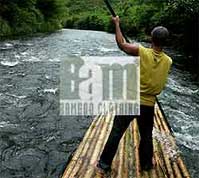Clean water for billions by 2015
Worldwide, more than one billion people lack access to an improved water source, such as a rainwater collection or wells. Two billion still need access to basic sanitation facilities.

By 2015, the international community, working through United Nations’ Millennium Development Goals adopted in September, hopes to reduce by half the number of people without safe drinking water and basic sanitation.
In the developed world, the moment a drop of water hits the ground it goes into the water system until it becomes wastewater. Then it’s treated and put it back into the system.
“We have a large-scale infrastructure in the United States to provide clean water,” said Joseph Hughes, chair of the Georgia Institute of Technology School of Civil and Environmental Engineering. “Using our current approach will not provide the rapid fix the United Nations is looking for in developing countries. It would take decades.”
Hughes outlined four steps to solving the developing world’s water and sanitation problems. First, researchers must determine how big the problem is, then analyze the water distribution process, understand the complexity of the systems required and, finally, create new approaches to water supply and sanitation through research and development, which might include new methods of storing, treating and disinfecting water and developing sanitation systems that minimize pathogen release.
Urbanization, climate changes, water scarcity and economic development will affect where water will be available in the future and where concentrated amounts of water will be required to meet the needs of large populations, Hughes says. The United Nations projects that two-thirds of the world’s population will live in areas that face water scarcity by 2025.
“Historically we’ve tried to go to groundwater sources, such as a well, to initiate improved water sources, but there’s a very finite capacity in groundwater,” Hughes noted. “We have to work much harder to make ocean or surface waters safe.”
The water must be safe and in reliable quantities
“We need to go beyond providing better water,” Hughes added. “We need to provide water that you and I would drink and consider safe. If a pregnant woman drank it, she wouldn’t be worried about her health or the baby’s health.”
In the United States, the only thing consumers need to know about their water supply is how to pay their bill and call a plumber if there’s a leak, said Cozzens, who organized the AAAS session on water and sanitation in developing countries. But a family in a developing country with a latrine needs to know a tremendous amount – how to build the latrine and how to maintain it.
“If a part breaks, what does that family do? Does the family stay in touch with the organization that came and provided the service or part originally? Is there someone who assumes the role of civil engineer in every town?” asked Cozzens.
Cozzens, in order to answer these questions, plans to investigate how communities in developing countries share their knowledge. She will conduct case studies in urban as well as rural locations in Mozambique, South Africa, Costa Rica and Brazil.
Cozzens’ goal is to provide insight to international and local water authorities helping developing countries set the right conditions for people to learn and solve the problems of unsafe water and sanitation.
Greener News Room
Keywords:: WATER SANITATION POVERTY INTERNATIONAL POLICY ENGINEERING INFRASTRUCTURE
TECHNICAL CONTACTS::
1. Susan Cozzens (404-385-0397); susan.cozzens@pubpolicy@gatech.edu
2. Joseph Hughes (404-894-2201); joseph.hughes@ce.gatech.edu

By 2015, the international community, working through United Nations’ Millennium Development Goals adopted in September, hopes to reduce by half the number of people without safe drinking water and basic sanitation.
In the developed world, the moment a drop of water hits the ground it goes into the water system until it becomes wastewater. Then it’s treated and put it back into the system.
“We have a large-scale infrastructure in the United States to provide clean water,” said Joseph Hughes, chair of the Georgia Institute of Technology School of Civil and Environmental Engineering. “Using our current approach will not provide the rapid fix the United Nations is looking for in developing countries. It would take decades.”
Hughes outlined four steps to solving the developing world’s water and sanitation problems. First, researchers must determine how big the problem is, then analyze the water distribution process, understand the complexity of the systems required and, finally, create new approaches to water supply and sanitation through research and development, which might include new methods of storing, treating and disinfecting water and developing sanitation systems that minimize pathogen release.
Urbanization, climate changes, water scarcity and economic development will affect where water will be available in the future and where concentrated amounts of water will be required to meet the needs of large populations, Hughes says. The United Nations projects that two-thirds of the world’s population will live in areas that face water scarcity by 2025.
“Historically we’ve tried to go to groundwater sources, such as a well, to initiate improved water sources, but there’s a very finite capacity in groundwater,” Hughes noted. “We have to work much harder to make ocean or surface waters safe.”
The water must be safe and in reliable quantities
“We need to go beyond providing better water,” Hughes added. “We need to provide water that you and I would drink and consider safe. If a pregnant woman drank it, she wouldn’t be worried about her health or the baby’s health.”
In the United States, the only thing consumers need to know about their water supply is how to pay their bill and call a plumber if there’s a leak, said Cozzens, who organized the AAAS session on water and sanitation in developing countries. But a family in a developing country with a latrine needs to know a tremendous amount – how to build the latrine and how to maintain it.
“If a part breaks, what does that family do? Does the family stay in touch with the organization that came and provided the service or part originally? Is there someone who assumes the role of civil engineer in every town?” asked Cozzens.
Cozzens, in order to answer these questions, plans to investigate how communities in developing countries share their knowledge. She will conduct case studies in urban as well as rural locations in Mozambique, South Africa, Costa Rica and Brazil.
Cozzens’ goal is to provide insight to international and local water authorities helping developing countries set the right conditions for people to learn and solve the problems of unsafe water and sanitation.
Greener News Room
Keywords:: WATER SANITATION POVERTY INTERNATIONAL POLICY ENGINEERING INFRASTRUCTURE
TECHNICAL CONTACTS::
1. Susan Cozzens (404-385-0397); susan.cozzens@pubpolicy@gatech.edu
2. Joseph Hughes (404-894-2201); joseph.hughes@ce.gatech.edu
Labels: Resources



3:07 PM









<< Home